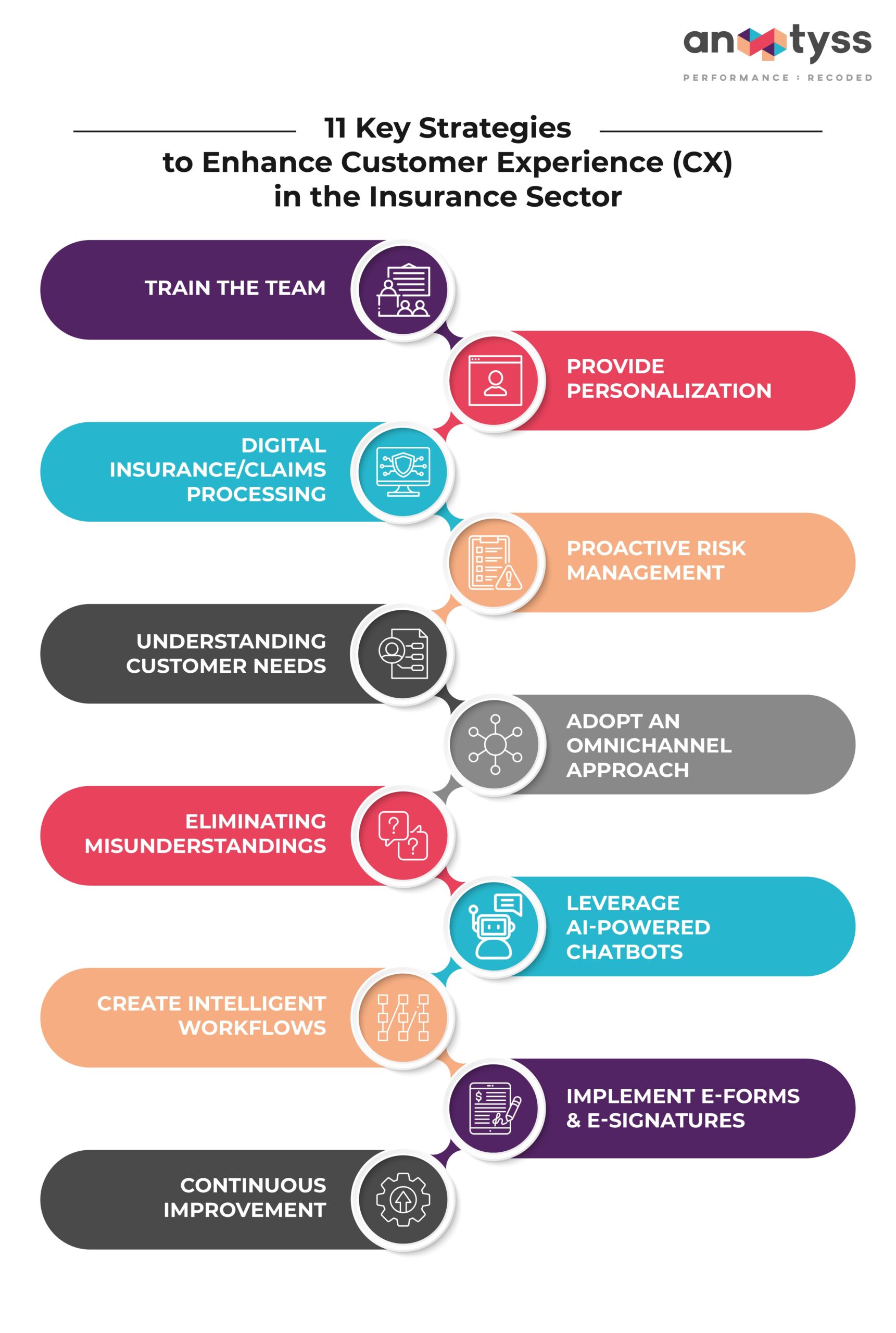This blog explores the importance of customer experience (CX) in the insurance industry and provides strategies to enhance it.
The insurance industry is a complex ecosystem in which the customer journey often involves multiple touchpoints, from the initial research phase to the purchasing of a policy, from filing a claim to renewing a policy. Each interaction shapes the customer’s perception of the insurer. In addition, customer expectations have also evolved.
Therefore, it is high time for insurance companies to expand their focus beyond managing risks and mitigating losses to becoming trusted advisers and allies to their policyholders (customers).
Importance of Customer Experience (CX) in the Insurance Industry
The insurance industry is built on trust.
Customers rely on insurance providers to protect their assets and health and provide financial security in times of need. Therefore, delivering on promises and providing a positive customer experience is crucial in establishing and maintaining this trust.
According to the report “The State of Connected Customer,” 84% of customers think that how a company treats them is just as important as what it sells. However, many businesses, including the insurance sector, are not able to meet these customer expectations.
Customers having a seamless and personalized experience with their insurance provider are more likely to feel valued and satisfied. This, in turn, can increase customer loyalty and retention.
Insurance companies that fail to prioritize customer experience are likely to experience the risk of losing customers to competitors who provide a superior CX.
According to the Capgemini report survey, more than 50% of customers prefer to use three or more channels to research and purchase insurance coverage on average.
Therefore, enhancing customer experience should not just be a matter of good business practice. It is critical for insurance companies’ long-term success and sustainability.
Challenges in the Insurance Industry
The insurance industry faces three main challenges in providing a superior customer experience and service quality.
- The complexity of insurance products and processes makes it difficult for the customer to comprehend the terms, coverage, and exclusions, leading to confusion, frustration, and poor customer experience.
- Lack of personalization in insurance products and services also poses a significant challenge, as many insurers still rely on a one-size-fits-all approach, which fails to meet customer expectations.
- The traditional paper-based manual processes and lengthy claim settlement procedures further contribute to delays and dissatisfied customers.
- Single-channel communication for policy issuance, insurance renewals, and customer interaction can help
11 Key Strategies for Enhancing Customer Experience in the Insurance Sector
1. Train the Sales and Servicing Team
A well-trained and knowledgeable team is the backbone of excellent customer experience (CX). Invest in comprehensive training programs and technology to help human agents handle customer queries and concerns effectively.
To ensure they have a deep understanding of insurance products, coverage options, and claims procedures, Insurers should:
- Provide ongoing training and development opportunities to empower their team and deliver exceptional customer service
- Develop detailed product manuals and documentation
- Conduct regular assessments
- Promote cross-functional training
- Create a digital learning environment or eLearning center to allow easy access to information, training materials, and processes.
- Encourage employees to seek ongoing education, skill enhancement, or industry certifications and training programs
2. Provide Tailored & Personalized Insurance Solutions
The insurance sector is a highly competitive market that leads to a constant battle of attracting new customers and retaining existing ones. As a result, customers become a mere number than actual people. Treating customers as a commodity is a sure-shot way of losing them permanently. Instead, insurance companies need to focus on hyper-personalization for superior customer experience.
According to McKinsey & Company report, “personalization — or reaching customers at the right time with targeted messaging, offers, and pricing — is the future of insurance marketing.”
For this, insurance companies can:
- Leverage data analytics and customer insights to analyze real-time data and offer tailored insurance solutions that meet individual needs.
- Implement automation to streamline processes, such as sales, marketing, renewals, etc.
- Use advanced segmentation techniques to identify specific customer groups and create personalized offerings.
Addressing customers’ requirements can make them feel valued and demonstrate that the insurer understands their needs and is committed to providing a tailored experience.
3. Digital Insurance/Claims Processing
In the digital age, customers have easy access to information and alternatives they can use to compare insurance providers and policies and switch to a different insurer in a few clicks.
Therefore, insurance companies must embrace digital transformation and streamline their insurance and claims processing.
- Implement user-friendly digital platforms
- Allow customers to manage their policies, submit claims, and track their status online.
Automating and digitizing the processes can improve efficiency and increase convenience and transparency.
4. Proactive Risk Management
The insurance industry encounters various risks in its line of business. These risks include financial, strategic, operational, compliance, reputational, ESG, etc., which can have catastrophic effects on the organization and threaten long-term sustainability. Therefore, insurance companies need a proactive approach toward risk management that helps focus on anticipating risk to prevent damage.
A proactive risk management program helps eliminate potential risks before they harm the business. The following are critical for a proactive risk management program:
- Risk identification and assessment
- Risk mitigation
- Continuous monitoring and adaptation
Proactive risk management also requires process automation, AI tools, and data analytics to analyze and measure risk and the efficiency of risk controls.
5. Understand Customer Needs & Behavior
Understanding the following is crucial to enhancing the customer experience:
- Needs
- Preferences
- Behavior
To gain insights into customer expectations and pain points,
- Conduct regular customer surveys
- Gather feedback
- Analyze customer data to identify trends and patterns
Insurers also need to understand why a customer buys a policy and what benefits they will get.
This understanding can help the insurance company be more customer-centric and proactive in anticipating customer needs and making informed decisions for a personalized experience.
6. Listen to Customers – Adopt an Omnichannel Approach to Interact with Customers
Actively listen and respond to customer feedback. Encourage customers to share their experiences, whether positive or negative. Also, demonstrate that their opinions matter.
By listening to the customers, insurers can:
- Build a long relationship, trust, and loyalty with customers
- Understand problems that lie in the insurer’s digital experience
- Identify which services customers are responding to and what they care about
- Continuously refine customer experience and offer improved products based on customers’ inputs
For this, insurers can take the following steps:
- Implement a robust feedback mechanism, including online customer surveys, ratings, etc.
- Train the staff in active listening skills. Teach them to be empathetic and proactive to understand customer thoughts and concerns.
- Monitor social media and other online reviews.
- Acknowledge and address customer complaints
- Create communication channels that allow customers to reach out easily through chat, email, call, or in-person meetings.
- Ensure consistent messaging and a unified experience across all channels.
7. Eliminate the Risk of Misunderstanding and Frustration
Misunderstanding of policy coverage is one of the biggest frustrations that customers face. Therefore, insurance providers must stay transparent with their policies, pricing, and procedures. The following points can help eliminate potential risks of misunderstanding:
- Ensure customers get the coverage they want – critical for building trust
- Ensure clear and transparent communication about policy terms, conditions, and exclusions
- Simplify the language used in policy documents to make them more accessible to customers
- Provide comprehensive and easy-to-understand explanations of coverage options during the purchase process.
Eliminating misunderstandings can instill confidence in customers and assure them of the expected coverage.
8. Leverage Artificial Intelligence (AI)-Powered Chatbots & Personalized Interactions
Emerging technologies, such as Artificial Intelligence (AI), Machine Learning (ML), Natural Language Processing (NLP), etc., have revolutionized customer service in various industries, including the insurance sector.
To ensure superior customer experience, insurers can Implement AI-powered chatbots to enable personalized interaction with customers. The benefit of deploying these chatbots is that:
- They can understand and answer frequently asked questions
- Address common queries, inquiries, and transactions
- Provide policy information
- Guide customers through the claims process
- Help in fraud detection
- Offer round-the-clock assistance (24/7)
- Improve response time and customer service
9. Create Intelligent Workflows for the Agents/Brokers and the Policyholders
Implement and deploy smart automation to automate and streamline workflows for both agents/brokers and policyholders.
Use intelligent digital solutions to automate routine and manual tasks to reduce the workload and allow agents to focus on innovative ideas that convert into business and provide personalized service/advice to customers.
For instance,
- Create an intelligent workflow for policyholders to simplify policy management, including policy enrolment, onboarding, payment reminders, claims submission, endorsements, and renewal notifications/processes.
- For brokers and agents, the insurer can create a workflow for new policy application and processing to automate and streamline the process of receiving, reviewing, and processing new policies, while ensuring compliance and regulatory checks.
10. Implement eForms and eSignatures
Replace traditional paper-based forms with electronic forms (eForms) to eliminate time-consuming and frustrating errors. Implement eSignatures to reduce customer rework and legal & compliance Issues.
eForms and eSignatures can help insurers streamline the application and claims processes, making them more efficient and error-free.
By digitizing these processes and providing customers with user-friendly, accessible means of submitting information and applications, insurers can reduce costs and enhance overall customer experience while fostering a competitive edge in the digital landscape.
11. Continuous Improvement
Continuous improvement is fundamental to improving customer experience and fostering customer-centricity that empowers organizations to deliver a better experience.
It involves feedback loops with customers to improve their experience, resulting in stronger customer loyalty and sustained business success. It also involves:
- Systematically identifying and addressing operational inefficiencies and customer pain points
- Streamlining processes
- Boosting employee engagement
- Ensuring consistency in service delivery
Embrace Customer – Centricity in the Insurance Sector
Customer experience plays a critical role in the success of insurance companies. Organizations that prioritize customer-centricity and embrace strategies to enhance CX are going to gain a competitive edge and build long-term customer loyalty.
By training the team, providing personalized tailored solutions, leveraging digital technology, listening to customers, and understanding their needs, the insurance provider can improve its products and services, eliminate errors, and augment the overall customer experience.
To learn more about enhancing customer experience in the Insurance sector, write to us: info@anaptyss.com.




